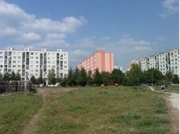Autonomous Republic of Prievidzia
Autonomous Republic of Prievidzia Autonómna republika Prievidzia | |
|---|---|
| Status | Autonomous region of Gishabrun |
| Capital | Artavia |
| Official languages | Slovak |
| Demonym(s) | Prievidzian |
| Government | Republic |
• President | TRH Jaroslav Ursanski |
• Head of Government | Jaromir Izbanski |
| Legislature | Senate |
| Establishment | 4 May 2012 |
| Population | |
• 2012 census | 2 |
| Currency | Gishabruni Brun |
This was a Gishabruni Autonomous Region | |
The Autonomous Republic of Prievidzia was an autonomous region of the Tsarist Empire of Gishabrun, which bordered Slovakia.
Etymology
The name "Prievidzia" is a corruption of "Prievidza", the name of the Slovakian town surrounding the autonomous region.
History
In October of 2011, two residents of Slovakia joined Gishabrun, and claimed an area of land known as Izbiak Oblast. This land claim was not recognised by the Gishabruni Government because it did not meet the standards required for Gishabruni oblastian land claims. Despite this, the locals, including individuals that were never given official Gishabruni citizenship, conducted themselves as citizens of a Gishabruni oblast until May 2012.

On January 3, 2012, some residents of the so-called Izbiak Oblast declared independence as Izba-Ursanistan, lead by Pribislav Medveđ and Jaroslav Ursanski. By January 14, Izba-Ursanistan had been conquered by Iztaria, a local micronation. The Gishabruni Izbiaks instead claimed two different areas known as Prizren and Izornia Oblasts. These land claims were also not recognised by the Gishabruni Government, and the locals refused to modify their claims to comply with Gishabruni law. This situation was brought to the Elite Duma in Gishabrun's first and only court case, Council of Prizren Oblast v. Tsar, which on March 30th, 2012, decided in favour of the Gishabruni Government and suggested that Prizren and Izornia Oblasts apply to become Autonomous Regions.
On April 5, 2012, the residents of Izornia Oblast claimed some nearby Slovakian land as Artavia Oblast to comply with the Elite Duma ruling on March 30th. However, the Izornians subsequently rebelled on April 9th, again under the leadership of Jaroslav Ursanski, and enlisted the support of the Itoriak Republic, a local micronation. This conflict sparked the Izornian War, which by April 12th resulted in the independence of Prizren Oblast as the Prizrenija Republic, and the consolidation of Artavia and Izornia Oblasts under local Gishabruni control. This conflict and land claims were not authorised or recognised by the Gishabruni Government, which continued to push for compliance with the Elite Duma ruling despite a major breakdown in communications between the government and the Izornians.
On May 4, 2012, the area previously claimed as Artavia and Izornia Oblasts was finally accepted by the Gishabruni Government as the Autonomous Republic of Prievidzia, which bordered Slovakia. On May 19th, Prievidzian delegates formally represented the Tsarist Empire at the Iryllian Security Council to attempt a peaceful resolution to the rebellion of the Slobodarsko-Jablonječka Republic against Slevania, a local micronation. This council instead resulted in the North Izkan War, in which Gishabruni citizens participated on the side of Slevania. The war resulted in a Slevanian victory on June 8th.
Prievidzia was returned to Slovakian sovereignty when Gishabrun was absorbed into Renasia on 22 July 2012. However, due to difficulties in establishing communication with the Autonomous Republic of Prievidzia, it is known that the Prievidzians swore fealty to the Tsar as late as November 1, 2012.
Government
The Autonomous Republic of Prievizia was governed as a republic, with the leadership being held by the President. It also had a legislature, known as the Senate. Not much else is known about the Prievidzian government due to difficulties in communication between Prievidzia and the Gishabruni government.
Geography

The climate of what was Prievidzia is continental, meaning it has an average of 4.8 degrees Celsius, with 66.2 mm of precipitation year-round. It was located near a river valley. Artavia was an area of apartment buildings and Izornia contained a grassy field. The Autonomous Republic of Prievidzia bordered Slovakia on all sides.
Culture
The Prievidzian culture was based on the Slovak culture, including elements such as the folk hero Jánošík and historical references to Great Moravia. This culture was represented in Gishabrun by the Izlovak Clan, and was known for strong Christian conservative values. Prievidzia was part of the Iryllian sector, and was influenced by the cultures of the local nations. This influence included the common use of the Izornian dialect of the Izbiak (or Prizav) constructed language, one of the Iryllian languages.

